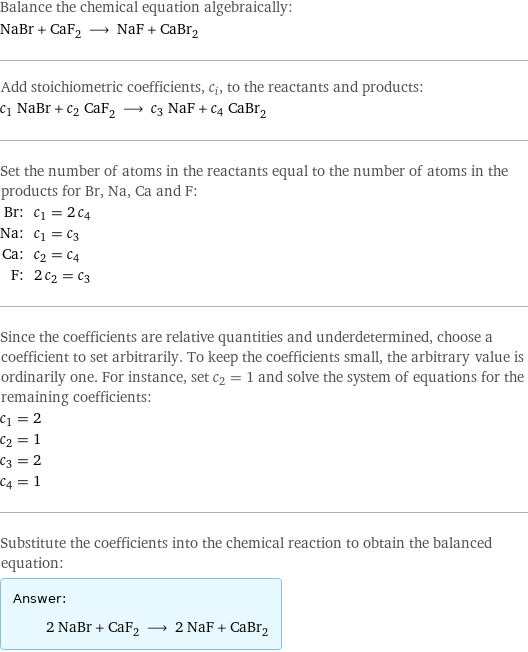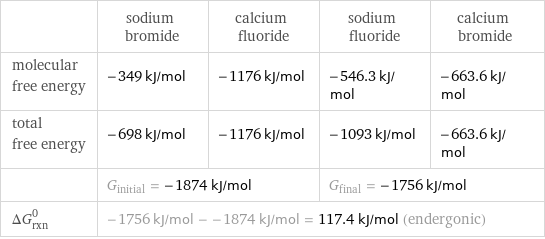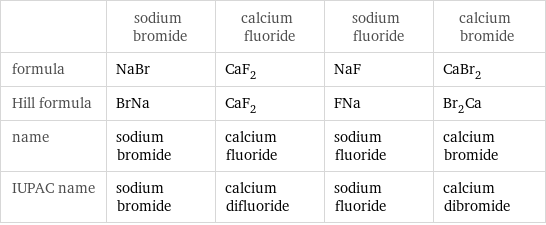Input interpretation

NaBr sodium bromide + CaF_2 calcium fluoride ⟶ NaF sodium fluoride + CaBr_2 calcium bromide
Balanced equation

Balance the chemical equation algebraically: NaBr + CaF_2 ⟶ NaF + CaBr_2 Add stoichiometric coefficients, c_i, to the reactants and products: c_1 NaBr + c_2 CaF_2 ⟶ c_3 NaF + c_4 CaBr_2 Set the number of atoms in the reactants equal to the number of atoms in the products for Br, Na, Ca and F: Br: | c_1 = 2 c_4 Na: | c_1 = c_3 Ca: | c_2 = c_4 F: | 2 c_2 = c_3 Since the coefficients are relative quantities and underdetermined, choose a coefficient to set arbitrarily. To keep the coefficients small, the arbitrary value is ordinarily one. For instance, set c_2 = 1 and solve the system of equations for the remaining coefficients: c_1 = 2 c_2 = 1 c_3 = 2 c_4 = 1 Substitute the coefficients into the chemical reaction to obtain the balanced equation: Answer: | | 2 NaBr + CaF_2 ⟶ 2 NaF + CaBr_2
Structures

+ ⟶ +
Names

sodium bromide + calcium fluoride ⟶ sodium fluoride + calcium bromide
Reaction thermodynamics
Enthalpy

| sodium bromide | calcium fluoride | sodium fluoride | calcium bromide molecular enthalpy | -361.1 kJ/mol | -1228 kJ/mol | -576.6 kJ/mol | -682.8 kJ/mol total enthalpy | -722.2 kJ/mol | -1228 kJ/mol | -1153 kJ/mol | -682.8 kJ/mol | H_initial = -1950 kJ/mol | | H_final = -1836 kJ/mol | ΔH_rxn^0 | -1836 kJ/mol - -1950 kJ/mol = 114.2 kJ/mol (endothermic) | | |
Gibbs free energy

| sodium bromide | calcium fluoride | sodium fluoride | calcium bromide molecular free energy | -349 kJ/mol | -1176 kJ/mol | -546.3 kJ/mol | -663.6 kJ/mol total free energy | -698 kJ/mol | -1176 kJ/mol | -1093 kJ/mol | -663.6 kJ/mol | G_initial = -1874 kJ/mol | | G_final = -1756 kJ/mol | ΔG_rxn^0 | -1756 kJ/mol - -1874 kJ/mol = 117.4 kJ/mol (endergonic) | | |
Equilibrium constant
![Construct the equilibrium constant, K, expression for: NaBr + CaF_2 ⟶ NaF + CaBr_2 Plan: • Balance the chemical equation. • Determine the stoichiometric numbers. • Assemble the activity expression for each chemical species. • Use the activity expressions to build the equilibrium constant expression. Write the balanced chemical equation: 2 NaBr + CaF_2 ⟶ 2 NaF + CaBr_2 Assign stoichiometric numbers, ν_i, using the stoichiometric coefficients, c_i, from the balanced chemical equation in the following manner: ν_i = -c_i for reactants and ν_i = c_i for products: chemical species | c_i | ν_i NaBr | 2 | -2 CaF_2 | 1 | -1 NaF | 2 | 2 CaBr_2 | 1 | 1 Assemble the activity expressions accounting for the state of matter and ν_i: chemical species | c_i | ν_i | activity expression NaBr | 2 | -2 | ([NaBr])^(-2) CaF_2 | 1 | -1 | ([CaF2])^(-1) NaF | 2 | 2 | ([NaF])^2 CaBr_2 | 1 | 1 | [CaBr2] The equilibrium constant symbol in the concentration basis is: K_c Mulitply the activity expressions to arrive at the K_c expression: Answer: | | K_c = ([NaBr])^(-2) ([CaF2])^(-1) ([NaF])^2 [CaBr2] = (([NaF])^2 [CaBr2])/(([NaBr])^2 [CaF2])](../image_source/adfa392c4a7f29f323728abfd4a05bcd.png)
Construct the equilibrium constant, K, expression for: NaBr + CaF_2 ⟶ NaF + CaBr_2 Plan: • Balance the chemical equation. • Determine the stoichiometric numbers. • Assemble the activity expression for each chemical species. • Use the activity expressions to build the equilibrium constant expression. Write the balanced chemical equation: 2 NaBr + CaF_2 ⟶ 2 NaF + CaBr_2 Assign stoichiometric numbers, ν_i, using the stoichiometric coefficients, c_i, from the balanced chemical equation in the following manner: ν_i = -c_i for reactants and ν_i = c_i for products: chemical species | c_i | ν_i NaBr | 2 | -2 CaF_2 | 1 | -1 NaF | 2 | 2 CaBr_2 | 1 | 1 Assemble the activity expressions accounting for the state of matter and ν_i: chemical species | c_i | ν_i | activity expression NaBr | 2 | -2 | ([NaBr])^(-2) CaF_2 | 1 | -1 | ([CaF2])^(-1) NaF | 2 | 2 | ([NaF])^2 CaBr_2 | 1 | 1 | [CaBr2] The equilibrium constant symbol in the concentration basis is: K_c Mulitply the activity expressions to arrive at the K_c expression: Answer: | | K_c = ([NaBr])^(-2) ([CaF2])^(-1) ([NaF])^2 [CaBr2] = (([NaF])^2 [CaBr2])/(([NaBr])^2 [CaF2])
Rate of reaction
![Construct the rate of reaction expression for: NaBr + CaF_2 ⟶ NaF + CaBr_2 Plan: • Balance the chemical equation. • Determine the stoichiometric numbers. • Assemble the rate term for each chemical species. • Write the rate of reaction expression. Write the balanced chemical equation: 2 NaBr + CaF_2 ⟶ 2 NaF + CaBr_2 Assign stoichiometric numbers, ν_i, using the stoichiometric coefficients, c_i, from the balanced chemical equation in the following manner: ν_i = -c_i for reactants and ν_i = c_i for products: chemical species | c_i | ν_i NaBr | 2 | -2 CaF_2 | 1 | -1 NaF | 2 | 2 CaBr_2 | 1 | 1 The rate term for each chemical species, B_i, is 1/ν_i(Δ[B_i])/(Δt) where [B_i] is the amount concentration and t is time: chemical species | c_i | ν_i | rate term NaBr | 2 | -2 | -1/2 (Δ[NaBr])/(Δt) CaF_2 | 1 | -1 | -(Δ[CaF2])/(Δt) NaF | 2 | 2 | 1/2 (Δ[NaF])/(Δt) CaBr_2 | 1 | 1 | (Δ[CaBr2])/(Δt) (for infinitesimal rate of change, replace Δ with d) Set the rate terms equal to each other to arrive at the rate expression: Answer: | | rate = -1/2 (Δ[NaBr])/(Δt) = -(Δ[CaF2])/(Δt) = 1/2 (Δ[NaF])/(Δt) = (Δ[CaBr2])/(Δt) (assuming constant volume and no accumulation of intermediates or side products)](../image_source/41b58f3a6a3c54d67e3d6b8382f247f0.png)
Construct the rate of reaction expression for: NaBr + CaF_2 ⟶ NaF + CaBr_2 Plan: • Balance the chemical equation. • Determine the stoichiometric numbers. • Assemble the rate term for each chemical species. • Write the rate of reaction expression. Write the balanced chemical equation: 2 NaBr + CaF_2 ⟶ 2 NaF + CaBr_2 Assign stoichiometric numbers, ν_i, using the stoichiometric coefficients, c_i, from the balanced chemical equation in the following manner: ν_i = -c_i for reactants and ν_i = c_i for products: chemical species | c_i | ν_i NaBr | 2 | -2 CaF_2 | 1 | -1 NaF | 2 | 2 CaBr_2 | 1 | 1 The rate term for each chemical species, B_i, is 1/ν_i(Δ[B_i])/(Δt) where [B_i] is the amount concentration and t is time: chemical species | c_i | ν_i | rate term NaBr | 2 | -2 | -1/2 (Δ[NaBr])/(Δt) CaF_2 | 1 | -1 | -(Δ[CaF2])/(Δt) NaF | 2 | 2 | 1/2 (Δ[NaF])/(Δt) CaBr_2 | 1 | 1 | (Δ[CaBr2])/(Δt) (for infinitesimal rate of change, replace Δ with d) Set the rate terms equal to each other to arrive at the rate expression: Answer: | | rate = -1/2 (Δ[NaBr])/(Δt) = -(Δ[CaF2])/(Δt) = 1/2 (Δ[NaF])/(Δt) = (Δ[CaBr2])/(Δt) (assuming constant volume and no accumulation of intermediates or side products)
Chemical names and formulas

| sodium bromide | calcium fluoride | sodium fluoride | calcium bromide formula | NaBr | CaF_2 | NaF | CaBr_2 Hill formula | BrNa | CaF_2 | FNa | Br_2Ca name | sodium bromide | calcium fluoride | sodium fluoride | calcium bromide IUPAC name | sodium bromide | calcium difluoride | sodium fluoride | calcium dibromide
Substance properties

| sodium bromide | calcium fluoride | sodium fluoride | calcium bromide molar mass | 102.89 g/mol | 78.075 g/mol | 41.98817244 g/mol | 199.89 g/mol phase | solid (at STP) | solid (at STP) | solid (at STP) | solid (at STP) melting point | 755 °C | 1418 °C | 993 °C | 730 °C boiling point | 1396 °C | 2500 °C | 1700 °C | 810 °C density | 3.2 g/cm^3 | 3.18 g/cm^3 | 2.558 g/cm^3 | 3.353 g/cm^3 solubility in water | soluble | | | soluble dynamic viscosity | | | 0.00105 Pa s (at 1160 °C) | odor | | | odorless |
Units
